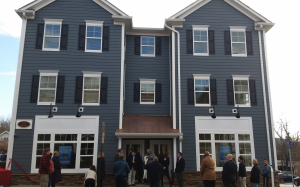Creating Affordable Housing Despite the Chaos at COAH

 Municipalities have been without COAH rules for over five years now. On-going litigation, moving obligation targets, and changing rules on what types of mechanisms will provide credits have left New Jersey communities hanging in the balance trying to decide what to do about it–if anything. Despite the uncertainty of COAH, each municipality in our state still has a constitutional mandate to provide affordable housing.
Municipalities have been without COAH rules for over five years now. On-going litigation, moving obligation targets, and changing rules on what types of mechanisms will provide credits have left New Jersey communities hanging in the balance trying to decide what to do about it–if anything. Despite the uncertainty of COAH, each municipality in our state still has a constitutional mandate to provide affordable housing.
Early in 2014, a developer who had received a building approval from High Bridge Borough in 2012, requested his permit for the development of a new 9,000 square foot mixed-use building. The building is within walking distance of the Borough’s train station and is proposed to contain two retail spaces and seven apartments. High Bridge, like many municipalities, has a COAH development fee ordinance. With limited in-house staff and the ongoing ambiguity with regard to COAH, the Borough reached out to their Planner for guidance regarding the COAH fee.
After some research, it was determined that the non-residential portion of the building was exempt from paying COAH fees as it met the deadlines for receiving approvals and pulling construction permits. However, the residential portion was subject to a 1.5% equalized assessed value fee for the first two of seven units, which complied with the density permitted under the ordinance. The remaining five units were subject to a 6% equalized assessed value fee, as the Zoning Board permitted an increase in residential density (D5 variance), for these units. As a result, the COAH fee was calculated to be roughly $15,000, which is a sizeable sum for a small downtown mixed-use project.
While an infusion of $15,000 would boost the Borough’s affordable housing trust fund, it was not nearly enough to construct an affordable unit from the ground up. The Planner suggested that the Borough offer the developer a second option in lieu of the fee – deed restrict one of the seven units as a COAH unit for 30 years. The Borough was open to the idea and promptly scheduled a meeting to discuss the amount of the fee and the alternative the Borough would offer. Prior to the meeting, the current COAH rental fees for Hunterdon County were researched to educate both the municipality and the developer.
When the Borough met with the developer, the developer was shocked at the computed COAH fee. The Borough then offered the alternative of deed-restricting one apartment as an affordable unit. Surprisingly, the COAH rent was roughly $200 less per month than what the developer was planning as rent. Based on the information provided by the Borough and its Planner, the developer elected to deed-restrict the unit instead of paying the fee. The collaboration between the Borough, planner, and developer resulted in High Bridge’s first affordable housing unit constructed during COAH’s Third Round. Following the decision, the Borough and its consultants also assisted the developer with the preparation of the deed restriction documents, operating manual, affirmative marketing plan, rental applications, and tenant income verification.
High Bridge has demonstrated that despite the fact that COAH is in chaos, there are still opportunities to deliver affordable housing. While the new mixed-use development only produced one COAH unit, it is still an additional opportunity that was successfully produced for one moderate-income family in the area to have housing that is not only new, but reasonably priced.
The ribbon cutting ceremony for the new mixed-use building was held December 17, 2014. High Bridge is an example to other small communities that there are opportunities to construct affordable housing, but it takes action on the part of the municipality and its consultants to start the dialogue with the development community.
Note from the Author I’d like to thank NJPO for publishing my story. This subject of this article was one small victory that was successfully completed just prior to the recent Supreme Court decision on March 10, 2015. As we move forward weaving our way toward satisfying future affordable obligations and obtaining constitutional compliance, we should still keep in mind that innovation in planning may still enable us to reach a satisfactory balance between local municipal goals and state-imposed mandates.
About the Author  Darlene Green, PP, AICP, a member of the NJPO, is the Borough Planner for High Bridge in Hunterdon County and an Associate at Maser Consulting P.A. Over the past several years she won the 2012 NJPO Achievement in Planning Award for High Bridge Sustainable Economic Development Plan; 2010 NJPO Achievement in Planning Award for Hazlet 2030 Vision Plan; and 2010 Monmouth County Planning Board Planning Award for Hazlet 2030 Vision Plan. She received her B.A. in Architecture at Lehigh University and her M.A. in City and Regional Planning at Rutgers University.
Darlene Green, PP, AICP, a member of the NJPO, is the Borough Planner for High Bridge in Hunterdon County and an Associate at Maser Consulting P.A. Over the past several years she won the 2012 NJPO Achievement in Planning Award for High Bridge Sustainable Economic Development Plan; 2010 NJPO Achievement in Planning Award for Hazlet 2030 Vision Plan; and 2010 Monmouth County Planning Board Planning Award for Hazlet 2030 Vision Plan. She received her B.A. in Architecture at Lehigh University and her M.A. in City and Regional Planning at Rutgers University.

March 20, 2015 at 9:51 am, Mary Codispoti said:
Congratulations to you and your team for blazing the trail for affordable housing opportunity in High Bridge!